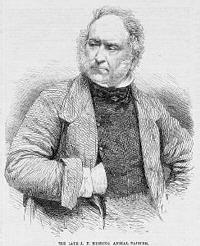
Renowned for an uncanny level of precision in his paintings, John Frederick Herring was adept at portraying an animal's individuality and emotional expression. Whether painting a thrilling race or a tranquil barnyard scene, Herring was meticulous in his execution, contributing to his status as one of the preeminent painters of animals in his day.
Herring was the son of a London merchant of Dutch parentage, who had been born in America. The first 18 years of his life were spent in London, where his greatest interests were drawing and horses. In 1814, he moved to Doncaster, arriving just in time to see the Duke of Hamilton's William win the St. Leger Stakes, the oldest of Britain's Five Classics that is still run today. In Doncaster, Herring first earned his living painting coach insignia and inn signs while also working as a night coach driver. His spare time was spent painting portraits of horses for inn parlors and he became known as the 'artist coachman'. Herring's talent was quickly recognized and he soon found himself painting hunters and racehorses for the gentry. From that point, he enjoyed a meteoric rise to artistic success, with his sons John Frederick Junior, Charles and Benjamin eventually becoming artists and his daughters Ann and Emma both marrying painters.
In 1833, Herring moved to London, where he suffered financial difficulties until being rescued by W. T. Copeland, who commissioned many paintings, including designs used for Copeland Spode bone china. In 1840-41, Herring visited Paris by invitation of the Duc d'Orleans (whom had heard of Herring's skill by one of his admirers, the famed Romanticist Theodore Gericault), for whom he painted several pictures. In 1845, Herring was appointed Animal Painter to HRH the Duchess of Kent, followed by a commission from Queen Victoria, who was to remain a patron for the rest of his life.
Herring spent the last 12 years of his life at Meopham Park near Tunbridge, where he lived as a country squire. He broadened his subject matter to paint agricultural and narrative scenes. A highly successful and prolific artist, Herring ranks with Sir Edwin Landseer as one of the most masterful animal painters of the 19th century. His paintings were very popular and many were transformed into engravings, including his 33 winners of the St Leger Stakes and his 21 winners of the Derby. Herring also won a large number of awards for his paintings.